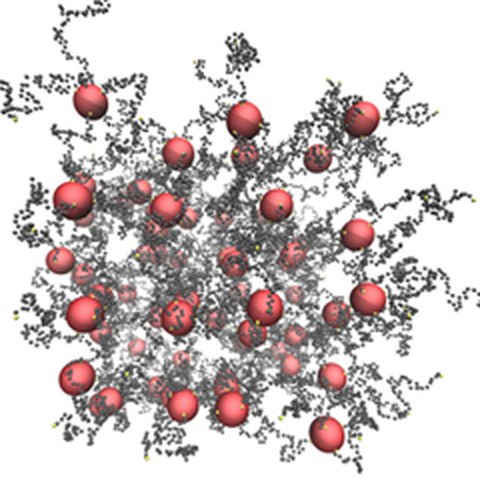Ch. Holm: Properties of magnetic hybrid materials - a microscopic simualtion approach
Description
In this project we plan to investigate the microstructure, the magnetic behavior, and the mechanical and viscoelastic properties of various magnetic gels on the basis of microscopic particle-based models. This is done on several levels of coarse-graining. On the most detailed level, the network structure of the gel is modeled as a network of connected bead-spring chains.
We considered essentially two
models that differ by the arrangements of the magnetic nanoparticles:
in the first one the magnetic (dipolar) particles are located at the network nodes and act as crosslinkers of the polymer gel. In the other model the nano magnets are part of the polymer chain backbone (as dipolar beads). Both models have experimental realizations. On a more coarse-grained level, the polymers are modelled as non-linear springs between the magnetic particles or as a network of such strings. These models are in particular suitable for cases, in which a large sample or long time scales have to be considered to understand the properties of a gel. One example would be the investigation of the shape-dependent deformation of a gel sample.
In the second phase, our aim is two-fold. On the one hand, we intend to extend the work on static properties such as deformational and elastic response based on the various models developed in the first funding period. On the other hand, we will study dynamic properties of the materials, such as their response to AC-fields and viscoelastic properties.

Snapshot of a gel sample in which the magnetic particles (red) act as cross-linkers. Six polymer chains are connected to each magnetic particle, and the network has the topology of a simple cubic network.
Project Manager
Prof. Dr. Christian Holm, ICP, Universität Stuttgart
Staff
Rudolf Weeber, ICP, Universität Stuttgart
Patrick Kreisel, ICP, Universität Stuttgart
Grant period
2013 -
Publications
[1] Z. Wang, Z.; C. Holm, H.W. Müller, Molecular dynamics study on the equilibrium magnetization properties and structure of ferrofluids, Phys. Rev. E 66, 021405, (2002).
[2] J.J. Cerda, P.A. Sanchez, C. Holm, T. Sintes, Phase diagram for a single flexible Stockmayer polymer at zero field, Soft Matter 9, 7185-7195 (2013).
[3] M. Klinkigt, R. Weeber, S.S. Kantorovich, C. Holm, Cluster formation in systems of shifted-dipole particles, Soft Matter 9, 3535-3546, (2013).
[4] R. Weeber, S.S. Kantorovich, C. Holm, Deformation mechanisms in 2D magnetic gels studied by computer simulations, Soft Matter 8, 9923-9932 (2012).
Contact
Institute for Computational Physics
Universität Stuttgart
Allmandring 3
70569 Stuttgart
